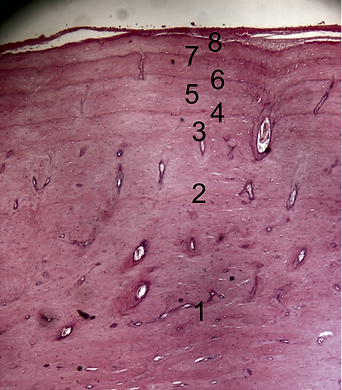Age Estimation of Florida Manatees
Overview
The Florida manatee (Trichechus manatus latirostris) is a sub-species of the West Indian manatee that primarily inhabits the coastal waters of the southeast United States. Even though Florida manatees were down-listed from endangered to threatened in 2017, there are still over 300 mortalities reported to the Florida Fish & Wildlife Conservation Commission (FWC) every year.
Understanding the age demographics of mammalian populations is important for implementing effective conservation efforts.


A manatee earbone

An annotated cross-section of a manatee earbone stained with hematoxylin & eosin to show the annual growth layer groups
Age Estimation - Accuracy, Precision, and Error
Ages of manatees can be estimated by counting growth layer groups (GLGs) in cross-sections of their earbones, similar to counting rings in a tree trunk. Each GLG is thought to represent one year in a manatee's life, except for a transition in bone structure during the first year (Marmontel et al. 1996).
Over the past two decades, the FWC collected earbones from over 100 known- or approximately-known-age manatees, allowing for a detailed analysis of accuracy, precision, and error associated with estimating the age of manatees.
This was the premise behind my 2019 publication in the Journal of Mammalogy. We found that, on average, age estimations made by trained readers were off by ±1.75 years, but that this error increased with increasing age of the manatee at death. This increase in error was due to "resorption", or the natural turnover of bone that increases as mammals get older and worse at processing calcium. Resorption can obscure GLGs, causing underestimations by approximately 2-18 years in individuals over 15 years old at death.
Such estimates of accuracy, precision, and error are important to factor into future models of manatee populations and demographics. Since the 2019 publication, however, the FWC has stopped collecting earbones. Instead, models have moved toward using total lengths - which are cheaper and easier to obtain from carcasses - to estimate age class (calf/subadult/adult) at death, although there might be some error associated with this simplified approach as well (see Figure 7 in Lonati et al. 2019).
Tetracycline Earbones
Another earbone study I conducted during my time with the FWC involved manatees that had been injected with tetracycline - a common antibiotic that has the unique property of being incorporated into actively mineralizing bone upon injection. Bones that incorporate tetracycline exhibit a fluorescent band on cross-section, which should correspond with the GLG deposited the same year of injection (see photo below).
Over the past couple decades, 10 manatees that were injected with tetracycline died, and FWC collected their earbones. Some of these manatees were injected over 30 years before death, presenting a unique opportunity to validate age estimation in older manatees. Stay tuned for the results of this study, which were just accepted for publication in the Wildlife Society Bulletin!

.jpg)